HI6005 - Management: Strategic Planning and General Framework Report
VerifiedAdded on 2022/10/17
|18
|4406
|21
Report
AI Summary
This report provides a comprehensive overview of strategic planning and its importance within an organizational framework. It delves into key concepts such as the definition of an organization, the process of strategic planning, and the application of tools like the BCG matrix to analyze business portfolios. The report explores product life cycle management, including product portfolio analysis and positioning analysis, and also examines Cisco's Flip camera as a case study. Furthermore, it covers SWOT analysis and Porter's competitive strategies, offering insights into how these elements contribute to effective business strategy. The analysis includes examples such as Nestle's product portfolio within the BCG matrix. Overall, the report aims to provide a solid understanding of strategic planning and its practical applications in a business environment.

Management 1
TITLE OF THE PAPER CENTERED AND IN CAPS LOCK
by Student’s Name
Code + Course Name
Professor’s Name
University Name
City, State
Date
TITLE OF THE PAPER CENTERED AND IN CAPS LOCK
by Student’s Name
Code + Course Name
Professor’s Name
University Name
City, State
Date
Paraphrase This Document
Need a fresh take? Get an instant paraphrase of this document with our AI Paraphraser
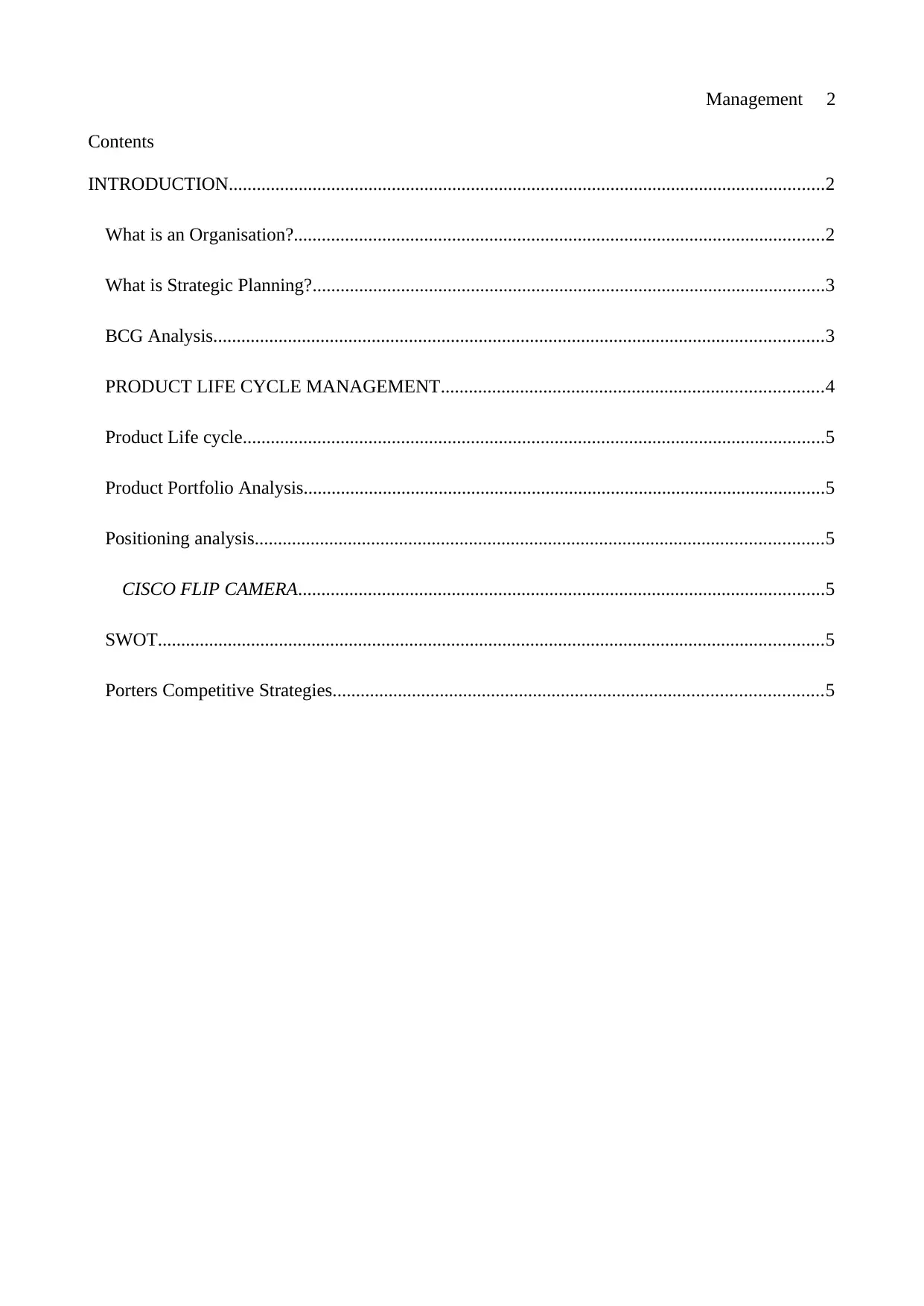
Management 2
Contents
INTRODUCTION................................................................................................................................2
What is an Organisation?..................................................................................................................2
What is Strategic Planning?..............................................................................................................3
BCG Analysis...................................................................................................................................3
PRODUCT LIFE CYCLE MANAGEMENT..................................................................................4
Product Life cycle.............................................................................................................................5
Product Portfolio Analysis................................................................................................................5
Positioning analysis..........................................................................................................................5
CISCO FLIP CAMERA.................................................................................................................5
SWOT...............................................................................................................................................5
Porters Competitive Strategies.........................................................................................................5
Contents
INTRODUCTION................................................................................................................................2
What is an Organisation?..................................................................................................................2
What is Strategic Planning?..............................................................................................................3
BCG Analysis...................................................................................................................................3
PRODUCT LIFE CYCLE MANAGEMENT..................................................................................4
Product Life cycle.............................................................................................................................5
Product Portfolio Analysis................................................................................................................5
Positioning analysis..........................................................................................................................5
CISCO FLIP CAMERA.................................................................................................................5
SWOT...............................................................................................................................................5
Porters Competitive Strategies.........................................................................................................5
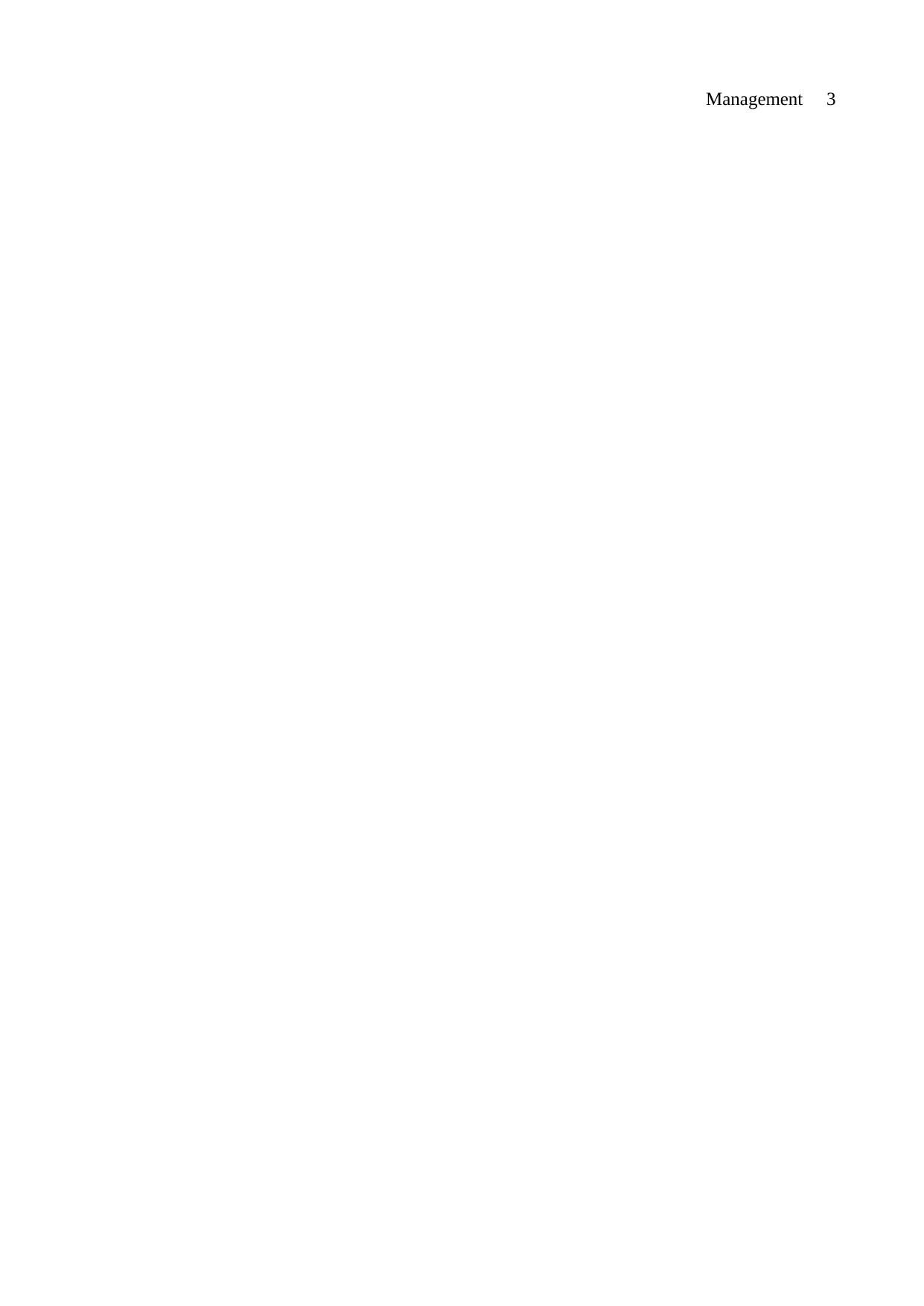
Management 3
⊘ This is a preview!⊘
Do you want full access?
Subscribe today to unlock all pages.

Trusted by 1+ million students worldwide
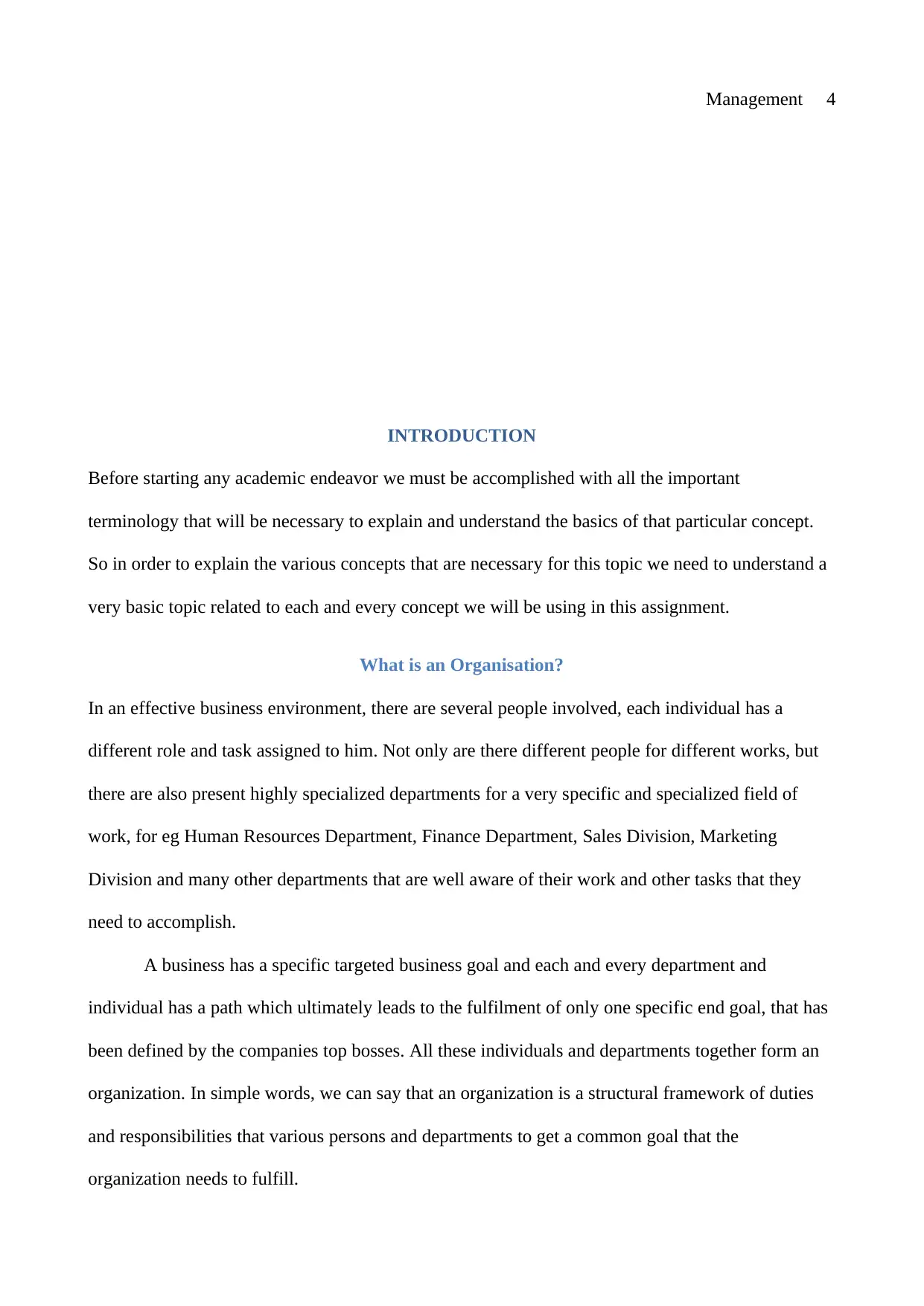
Management 4
INTRODUCTION
Before starting any academic endeavor we must be accomplished with all the important
terminology that will be necessary to explain and understand the basics of that particular concept.
So in order to explain the various concepts that are necessary for this topic we need to understand a
very basic topic related to each and every concept we will be using in this assignment.
What is an Organisation?
In an effective business environment, there are several people involved, each individual has a
different role and task assigned to him. Not only are there different people for different works, but
there are also present highly specialized departments for a very specific and specialized field of
work, for eg Human Resources Department, Finance Department, Sales Division, Marketing
Division and many other departments that are well aware of their work and other tasks that they
need to accomplish.
A business has a specific targeted business goal and each and every department and
individual has a path which ultimately leads to the fulfilment of only one specific end goal, that has
been defined by the companies top bosses. All these individuals and departments together form an
organization. In simple words, we can say that an organization is a structural framework of duties
and responsibilities that various persons and departments to get a common goal that the
organization needs to fulfill.
INTRODUCTION
Before starting any academic endeavor we must be accomplished with all the important
terminology that will be necessary to explain and understand the basics of that particular concept.
So in order to explain the various concepts that are necessary for this topic we need to understand a
very basic topic related to each and every concept we will be using in this assignment.
What is an Organisation?
In an effective business environment, there are several people involved, each individual has a
different role and task assigned to him. Not only are there different people for different works, but
there are also present highly specialized departments for a very specific and specialized field of
work, for eg Human Resources Department, Finance Department, Sales Division, Marketing
Division and many other departments that are well aware of their work and other tasks that they
need to accomplish.
A business has a specific targeted business goal and each and every department and
individual has a path which ultimately leads to the fulfilment of only one specific end goal, that has
been defined by the companies top bosses. All these individuals and departments together form an
organization. In simple words, we can say that an organization is a structural framework of duties
and responsibilities that various persons and departments to get a common goal that the
organization needs to fulfill.
Paraphrase This Document
Need a fresh take? Get an instant paraphrase of this document with our AI Paraphraser
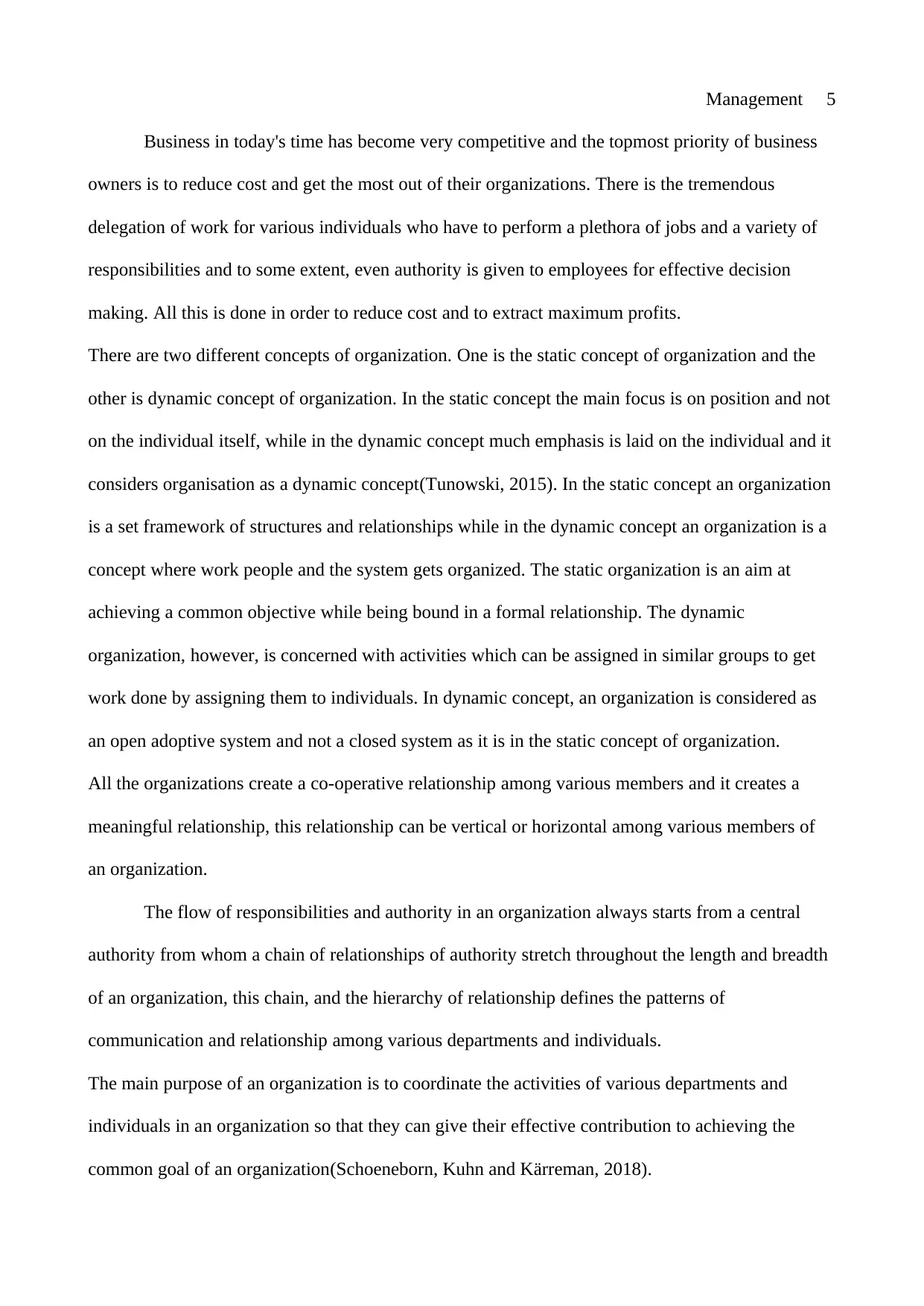
Management 5
Business in today's time has become very competitive and the topmost priority of business
owners is to reduce cost and get the most out of their organizations. There is the tremendous
delegation of work for various individuals who have to perform a plethora of jobs and a variety of
responsibilities and to some extent, even authority is given to employees for effective decision
making. All this is done in order to reduce cost and to extract maximum profits.
There are two different concepts of organization. One is the static concept of organization and the
other is dynamic concept of organization. In the static concept the main focus is on position and not
on the individual itself, while in the dynamic concept much emphasis is laid on the individual and it
considers organisation as a dynamic concept(Tunowski, 2015). In the static concept an organization
is a set framework of structures and relationships while in the dynamic concept an organization is a
concept where work people and the system gets organized. The static organization is an aim at
achieving a common objective while being bound in a formal relationship. The dynamic
organization, however, is concerned with activities which can be assigned in similar groups to get
work done by assigning them to individuals. In dynamic concept, an organization is considered as
an open adoptive system and not a closed system as it is in the static concept of organization.
All the organizations create a co-operative relationship among various members and it creates a
meaningful relationship, this relationship can be vertical or horizontal among various members of
an organization.
The flow of responsibilities and authority in an organization always starts from a central
authority from whom a chain of relationships of authority stretch throughout the length and breadth
of an organization, this chain, and the hierarchy of relationship defines the patterns of
communication and relationship among various departments and individuals.
The main purpose of an organization is to coordinate the activities of various departments and
individuals in an organization so that they can give their effective contribution to achieving the
common goal of an organization(Schoeneborn, Kuhn and Kärreman, 2018).
Business in today's time has become very competitive and the topmost priority of business
owners is to reduce cost and get the most out of their organizations. There is the tremendous
delegation of work for various individuals who have to perform a plethora of jobs and a variety of
responsibilities and to some extent, even authority is given to employees for effective decision
making. All this is done in order to reduce cost and to extract maximum profits.
There are two different concepts of organization. One is the static concept of organization and the
other is dynamic concept of organization. In the static concept the main focus is on position and not
on the individual itself, while in the dynamic concept much emphasis is laid on the individual and it
considers organisation as a dynamic concept(Tunowski, 2015). In the static concept an organization
is a set framework of structures and relationships while in the dynamic concept an organization is a
concept where work people and the system gets organized. The static organization is an aim at
achieving a common objective while being bound in a formal relationship. The dynamic
organization, however, is concerned with activities which can be assigned in similar groups to get
work done by assigning them to individuals. In dynamic concept, an organization is considered as
an open adoptive system and not a closed system as it is in the static concept of organization.
All the organizations create a co-operative relationship among various members and it creates a
meaningful relationship, this relationship can be vertical or horizontal among various members of
an organization.
The flow of responsibilities and authority in an organization always starts from a central
authority from whom a chain of relationships of authority stretch throughout the length and breadth
of an organization, this chain, and the hierarchy of relationship defines the patterns of
communication and relationship among various departments and individuals.
The main purpose of an organization is to coordinate the activities of various departments and
individuals in an organization so that they can give their effective contribution to achieving the
common goal of an organization(Schoeneborn, Kuhn and Kärreman, 2018).
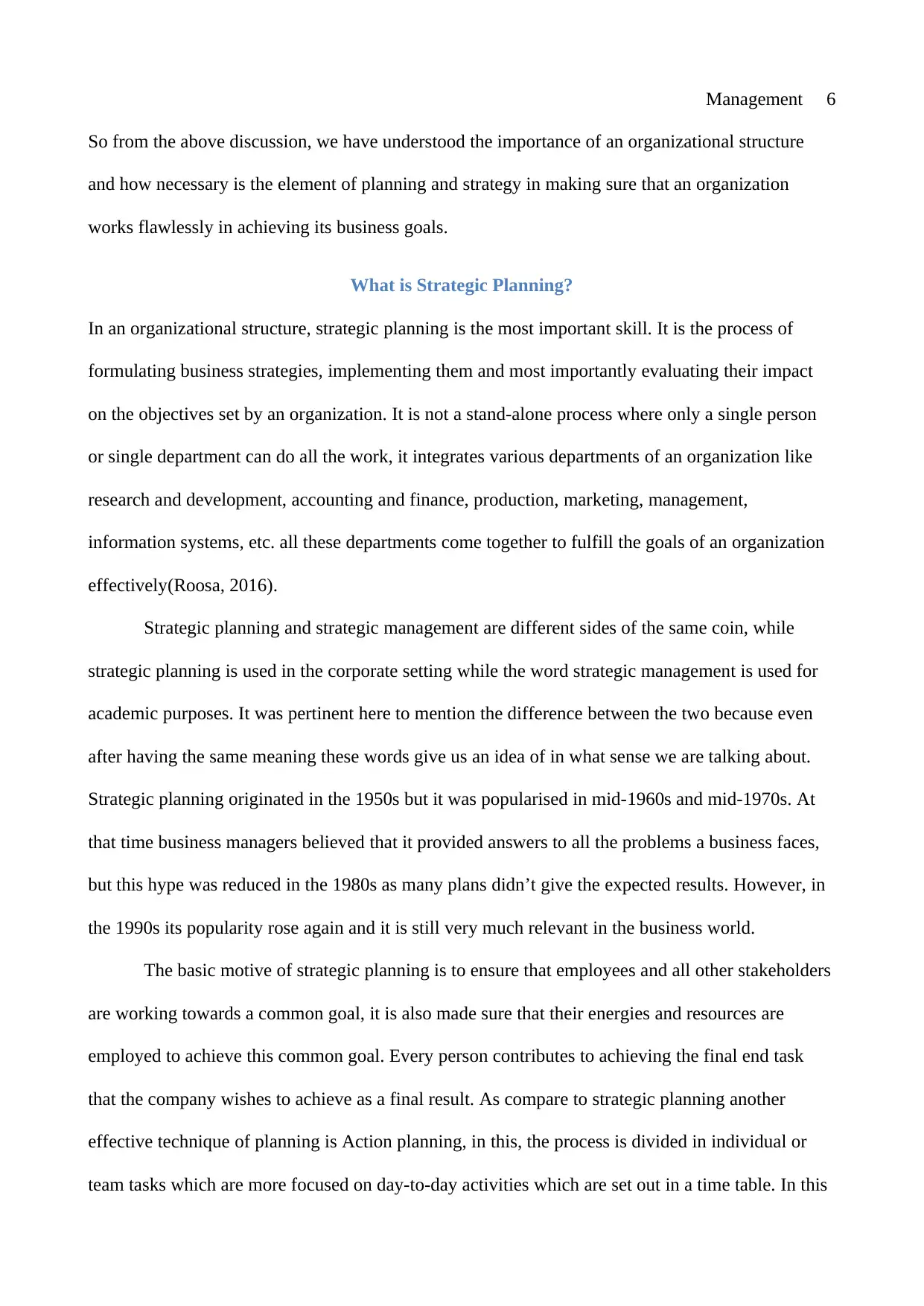
Management 6
So from the above discussion, we have understood the importance of an organizational structure
and how necessary is the element of planning and strategy in making sure that an organization
works flawlessly in achieving its business goals.
What is Strategic Planning?
In an organizational structure, strategic planning is the most important skill. It is the process of
formulating business strategies, implementing them and most importantly evaluating their impact
on the objectives set by an organization. It is not a stand-alone process where only a single person
or single department can do all the work, it integrates various departments of an organization like
research and development, accounting and finance, production, marketing, management,
information systems, etc. all these departments come together to fulfill the goals of an organization
effectively(Roosa, 2016).
Strategic planning and strategic management are different sides of the same coin, while
strategic planning is used in the corporate setting while the word strategic management is used for
academic purposes. It was pertinent here to mention the difference between the two because even
after having the same meaning these words give us an idea of in what sense we are talking about.
Strategic planning originated in the 1950s but it was popularised in mid-1960s and mid-1970s. At
that time business managers believed that it provided answers to all the problems a business faces,
but this hype was reduced in the 1980s as many plans didn’t give the expected results. However, in
the 1990s its popularity rose again and it is still very much relevant in the business world.
The basic motive of strategic planning is to ensure that employees and all other stakeholders
are working towards a common goal, it is also made sure that their energies and resources are
employed to achieve this common goal. Every person contributes to achieving the final end task
that the company wishes to achieve as a final result. As compare to strategic planning another
effective technique of planning is Action planning, in this, the process is divided in individual or
team tasks which are more focused on day-to-day activities which are set out in a time table. In this
So from the above discussion, we have understood the importance of an organizational structure
and how necessary is the element of planning and strategy in making sure that an organization
works flawlessly in achieving its business goals.
What is Strategic Planning?
In an organizational structure, strategic planning is the most important skill. It is the process of
formulating business strategies, implementing them and most importantly evaluating their impact
on the objectives set by an organization. It is not a stand-alone process where only a single person
or single department can do all the work, it integrates various departments of an organization like
research and development, accounting and finance, production, marketing, management,
information systems, etc. all these departments come together to fulfill the goals of an organization
effectively(Roosa, 2016).
Strategic planning and strategic management are different sides of the same coin, while
strategic planning is used in the corporate setting while the word strategic management is used for
academic purposes. It was pertinent here to mention the difference between the two because even
after having the same meaning these words give us an idea of in what sense we are talking about.
Strategic planning originated in the 1950s but it was popularised in mid-1960s and mid-1970s. At
that time business managers believed that it provided answers to all the problems a business faces,
but this hype was reduced in the 1980s as many plans didn’t give the expected results. However, in
the 1990s its popularity rose again and it is still very much relevant in the business world.
The basic motive of strategic planning is to ensure that employees and all other stakeholders
are working towards a common goal, it is also made sure that their energies and resources are
employed to achieve this common goal. Every person contributes to achieving the final end task
that the company wishes to achieve as a final result. As compare to strategic planning another
effective technique of planning is Action planning, in this, the process is divided in individual or
team tasks which are more focused on day-to-day activities which are set out in a time table. In this
⊘ This is a preview!⊘
Do you want full access?
Subscribe today to unlock all pages.

Trusted by 1+ million students worldwide
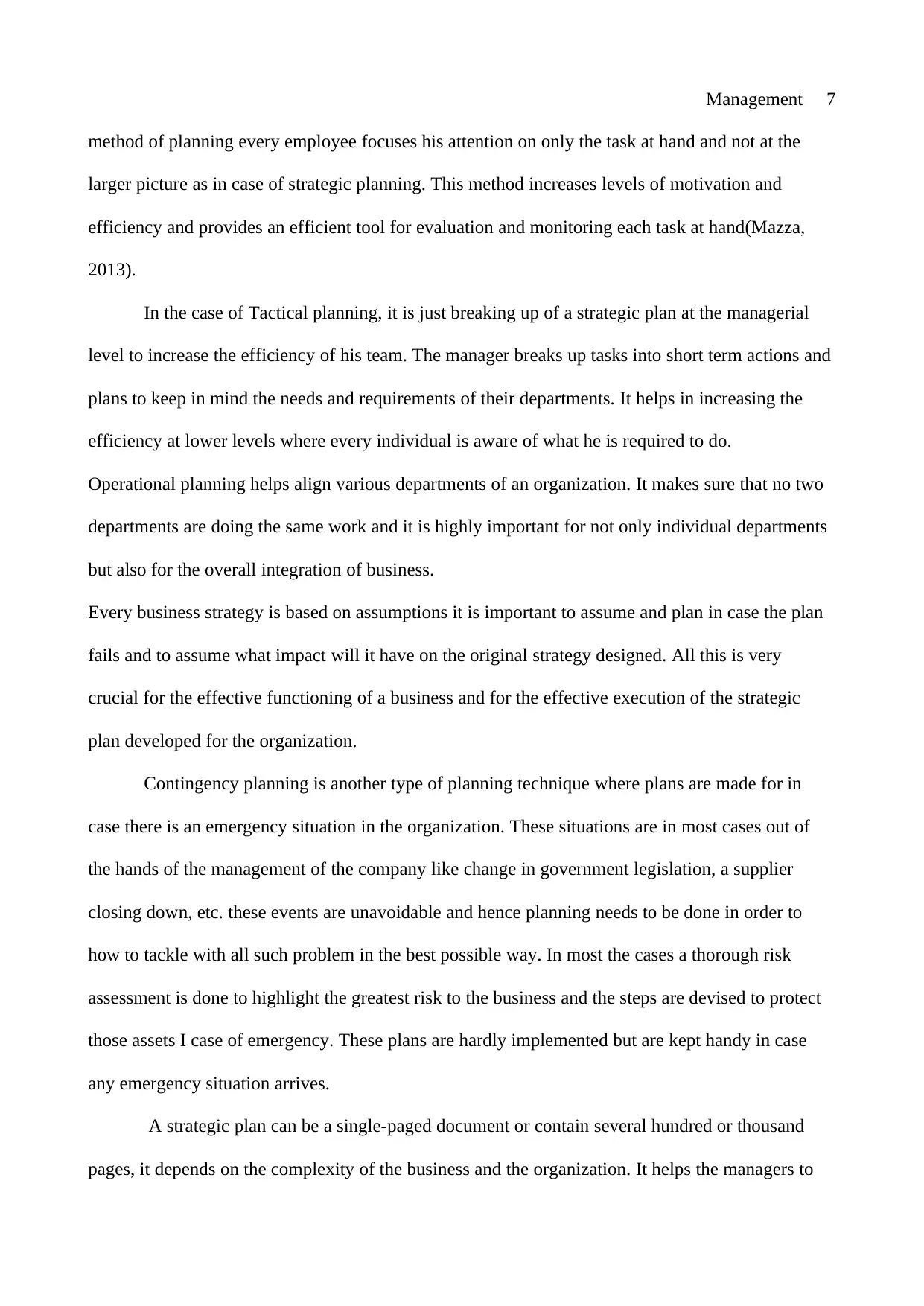
Management 7
method of planning every employee focuses his attention on only the task at hand and not at the
larger picture as in case of strategic planning. This method increases levels of motivation and
efficiency and provides an efficient tool for evaluation and monitoring each task at hand(Mazza,
2013).
In the case of Tactical planning, it is just breaking up of a strategic plan at the managerial
level to increase the efficiency of his team. The manager breaks up tasks into short term actions and
plans to keep in mind the needs and requirements of their departments. It helps in increasing the
efficiency at lower levels where every individual is aware of what he is required to do.
Operational planning helps align various departments of an organization. It makes sure that no two
departments are doing the same work and it is highly important for not only individual departments
but also for the overall integration of business.
Every business strategy is based on assumptions it is important to assume and plan in case the plan
fails and to assume what impact will it have on the original strategy designed. All this is very
crucial for the effective functioning of a business and for the effective execution of the strategic
plan developed for the organization.
Contingency planning is another type of planning technique where plans are made for in
case there is an emergency situation in the organization. These situations are in most cases out of
the hands of the management of the company like change in government legislation, a supplier
closing down, etc. these events are unavoidable and hence planning needs to be done in order to
how to tackle with all such problem in the best possible way. In most the cases a thorough risk
assessment is done to highlight the greatest risk to the business and the steps are devised to protect
those assets I case of emergency. These plans are hardly implemented but are kept handy in case
any emergency situation arrives.
A strategic plan can be a single-paged document or contain several hundred or thousand
pages, it depends on the complexity of the business and the organization. It helps the managers to
method of planning every employee focuses his attention on only the task at hand and not at the
larger picture as in case of strategic planning. This method increases levels of motivation and
efficiency and provides an efficient tool for evaluation and monitoring each task at hand(Mazza,
2013).
In the case of Tactical planning, it is just breaking up of a strategic plan at the managerial
level to increase the efficiency of his team. The manager breaks up tasks into short term actions and
plans to keep in mind the needs and requirements of their departments. It helps in increasing the
efficiency at lower levels where every individual is aware of what he is required to do.
Operational planning helps align various departments of an organization. It makes sure that no two
departments are doing the same work and it is highly important for not only individual departments
but also for the overall integration of business.
Every business strategy is based on assumptions it is important to assume and plan in case the plan
fails and to assume what impact will it have on the original strategy designed. All this is very
crucial for the effective functioning of a business and for the effective execution of the strategic
plan developed for the organization.
Contingency planning is another type of planning technique where plans are made for in
case there is an emergency situation in the organization. These situations are in most cases out of
the hands of the management of the company like change in government legislation, a supplier
closing down, etc. these events are unavoidable and hence planning needs to be done in order to
how to tackle with all such problem in the best possible way. In most the cases a thorough risk
assessment is done to highlight the greatest risk to the business and the steps are devised to protect
those assets I case of emergency. These plans are hardly implemented but are kept handy in case
any emergency situation arrives.
A strategic plan can be a single-paged document or contain several hundred or thousand
pages, it depends on the complexity of the business and the organization. It helps the managers to
Paraphrase This Document
Need a fresh take? Get an instant paraphrase of this document with our AI Paraphraser
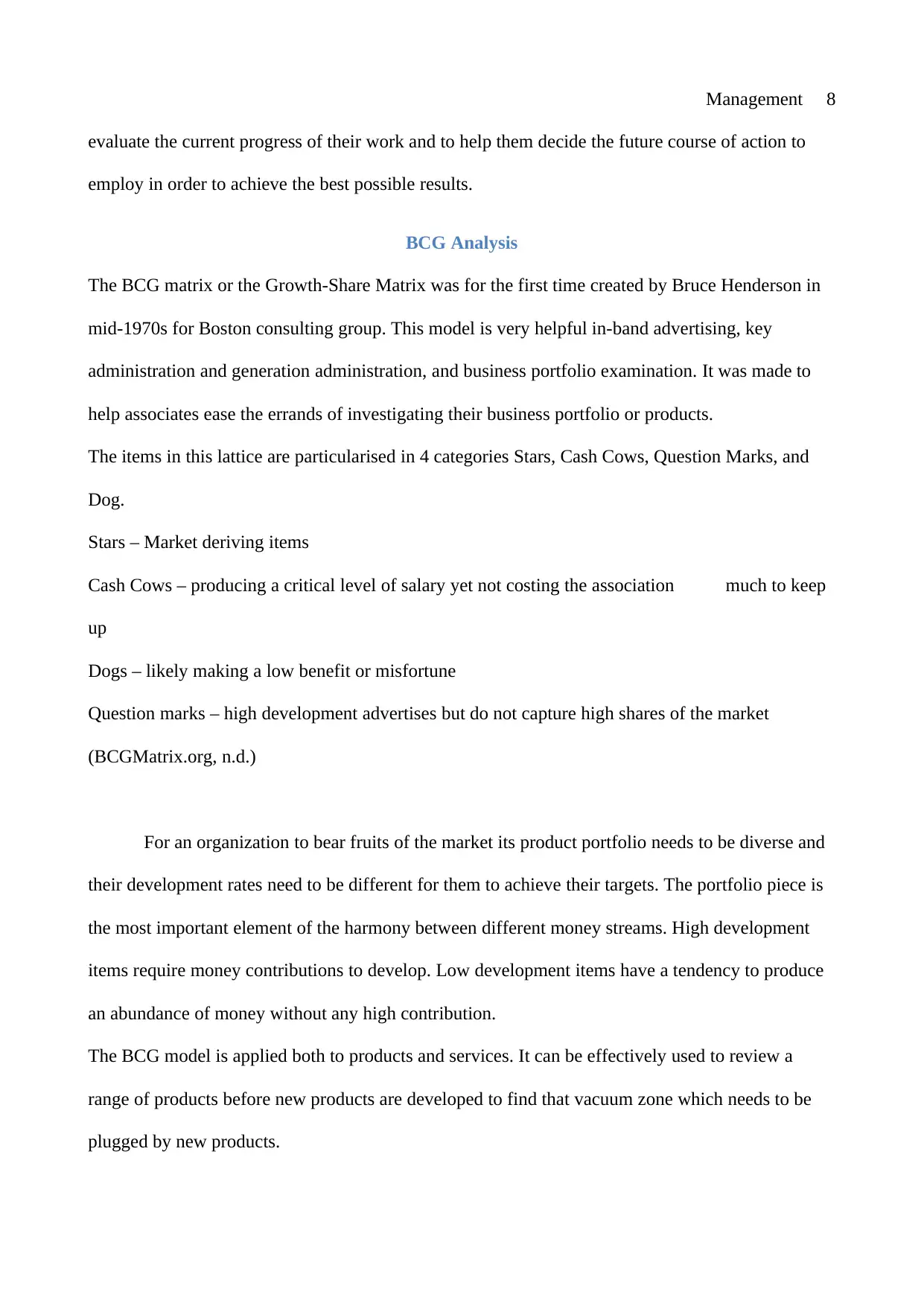
Management 8
evaluate the current progress of their work and to help them decide the future course of action to
employ in order to achieve the best possible results.
BCG Analysis
The BCG matrix or the Growth-Share Matrix was for the first time created by Bruce Henderson in
mid-1970s for Boston consulting group. This model is very helpful in-band advertising, key
administration and generation administration, and business portfolio examination. It was made to
help associates ease the errands of investigating their business portfolio or products.
The items in this lattice are particularised in 4 categories Stars, Cash Cows, Question Marks, and
Dog.
Stars – Market deriving items
Cash Cows – producing a critical level of salary yet not costing the association much to keep
up
Dogs – likely making a low benefit or misfortune
Question marks – high development advertises but do not capture high shares of the market
(BCGMatrix.org, n.d.)
For an organization to bear fruits of the market its product portfolio needs to be diverse and
their development rates need to be different for them to achieve their targets. The portfolio piece is
the most important element of the harmony between different money streams. High development
items require money contributions to develop. Low development items have a tendency to produce
an abundance of money without any high contribution.
The BCG model is applied both to products and services. It can be effectively used to review a
range of products before new products are developed to find that vacuum zone which needs to be
plugged by new products.
evaluate the current progress of their work and to help them decide the future course of action to
employ in order to achieve the best possible results.
BCG Analysis
The BCG matrix or the Growth-Share Matrix was for the first time created by Bruce Henderson in
mid-1970s for Boston consulting group. This model is very helpful in-band advertising, key
administration and generation administration, and business portfolio examination. It was made to
help associates ease the errands of investigating their business portfolio or products.
The items in this lattice are particularised in 4 categories Stars, Cash Cows, Question Marks, and
Dog.
Stars – Market deriving items
Cash Cows – producing a critical level of salary yet not costing the association much to keep
up
Dogs – likely making a low benefit or misfortune
Question marks – high development advertises but do not capture high shares of the market
(BCGMatrix.org, n.d.)
For an organization to bear fruits of the market its product portfolio needs to be diverse and
their development rates need to be different for them to achieve their targets. The portfolio piece is
the most important element of the harmony between different money streams. High development
items require money contributions to develop. Low development items have a tendency to produce
an abundance of money without any high contribution.
The BCG model is applied both to products and services. It can be effectively used to review a
range of products before new products are developed to find that vacuum zone which needs to be
plugged by new products.
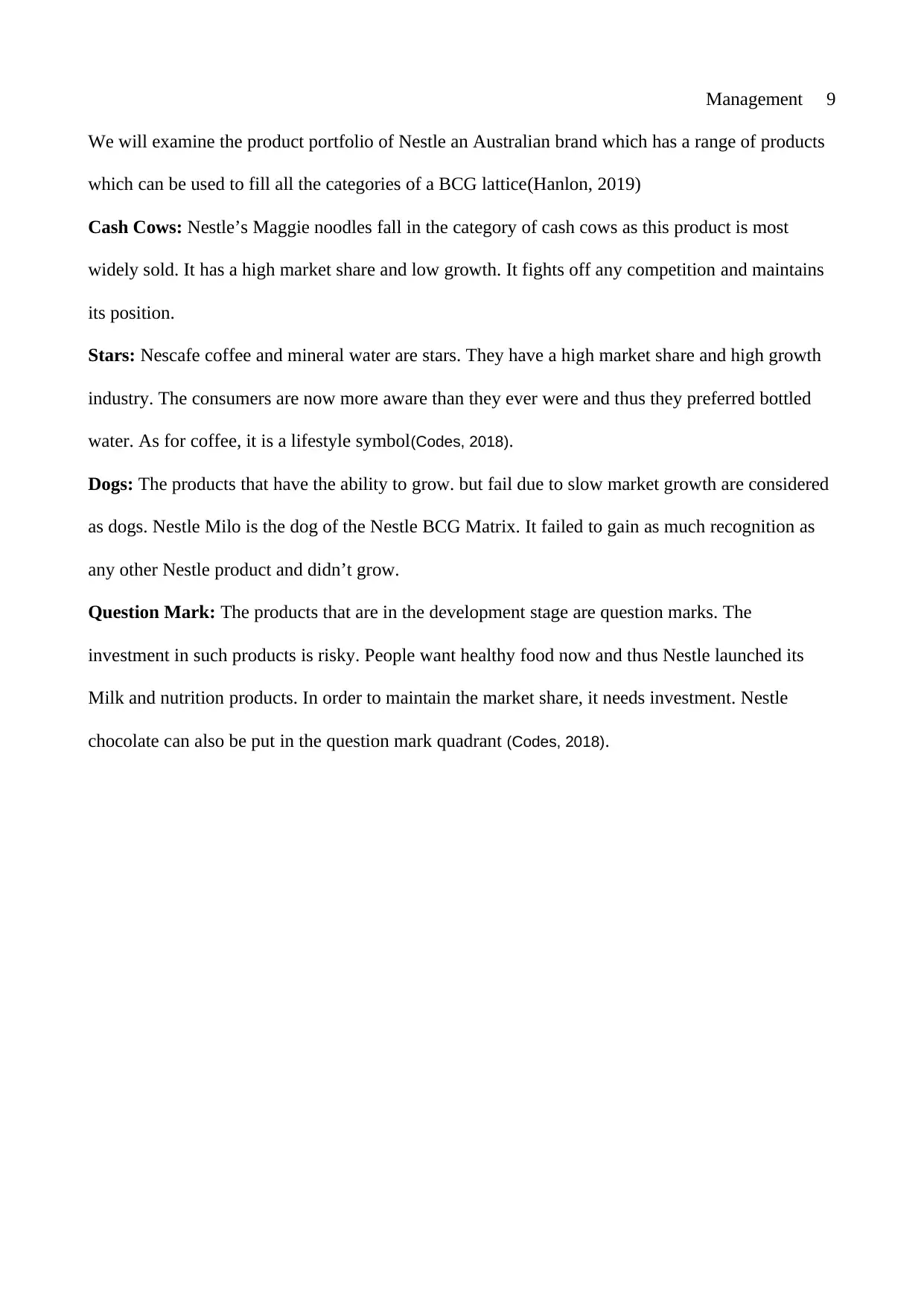
Management 9
We will examine the product portfolio of Nestle an Australian brand which has a range of products
which can be used to fill all the categories of a BCG lattice(Hanlon, 2019)
Cash Cows: Nestle’s Maggie noodles fall in the category of cash cows as this product is most
widely sold. It has a high market share and low growth. It fights off any competition and maintains
its position.
Stars: Nescafe coffee and mineral water are stars. They have a high market share and high growth
industry. The consumers are now more aware than they ever were and thus they preferred bottled
water. As for coffee, it is a lifestyle symbol(Codes, 2018).
Dogs: The products that have the ability to grow. but fail due to slow market growth are considered
as dogs. Nestle Milo is the dog of the Nestle BCG Matrix. It failed to gain as much recognition as
any other Nestle product and didn’t grow.
Question Mark: The products that are in the development stage are question marks. The
investment in such products is risky. People want healthy food now and thus Nestle launched its
Milk and nutrition products. In order to maintain the market share, it needs investment. Nestle
chocolate can also be put in the question mark quadrant (Codes, 2018).
We will examine the product portfolio of Nestle an Australian brand which has a range of products
which can be used to fill all the categories of a BCG lattice(Hanlon, 2019)
Cash Cows: Nestle’s Maggie noodles fall in the category of cash cows as this product is most
widely sold. It has a high market share and low growth. It fights off any competition and maintains
its position.
Stars: Nescafe coffee and mineral water are stars. They have a high market share and high growth
industry. The consumers are now more aware than they ever were and thus they preferred bottled
water. As for coffee, it is a lifestyle symbol(Codes, 2018).
Dogs: The products that have the ability to grow. but fail due to slow market growth are considered
as dogs. Nestle Milo is the dog of the Nestle BCG Matrix. It failed to gain as much recognition as
any other Nestle product and didn’t grow.
Question Mark: The products that are in the development stage are question marks. The
investment in such products is risky. People want healthy food now and thus Nestle launched its
Milk and nutrition products. In order to maintain the market share, it needs investment. Nestle
chocolate can also be put in the question mark quadrant (Codes, 2018).
⊘ This is a preview!⊘
Do you want full access?
Subscribe today to unlock all pages.

Trusted by 1+ million students worldwide
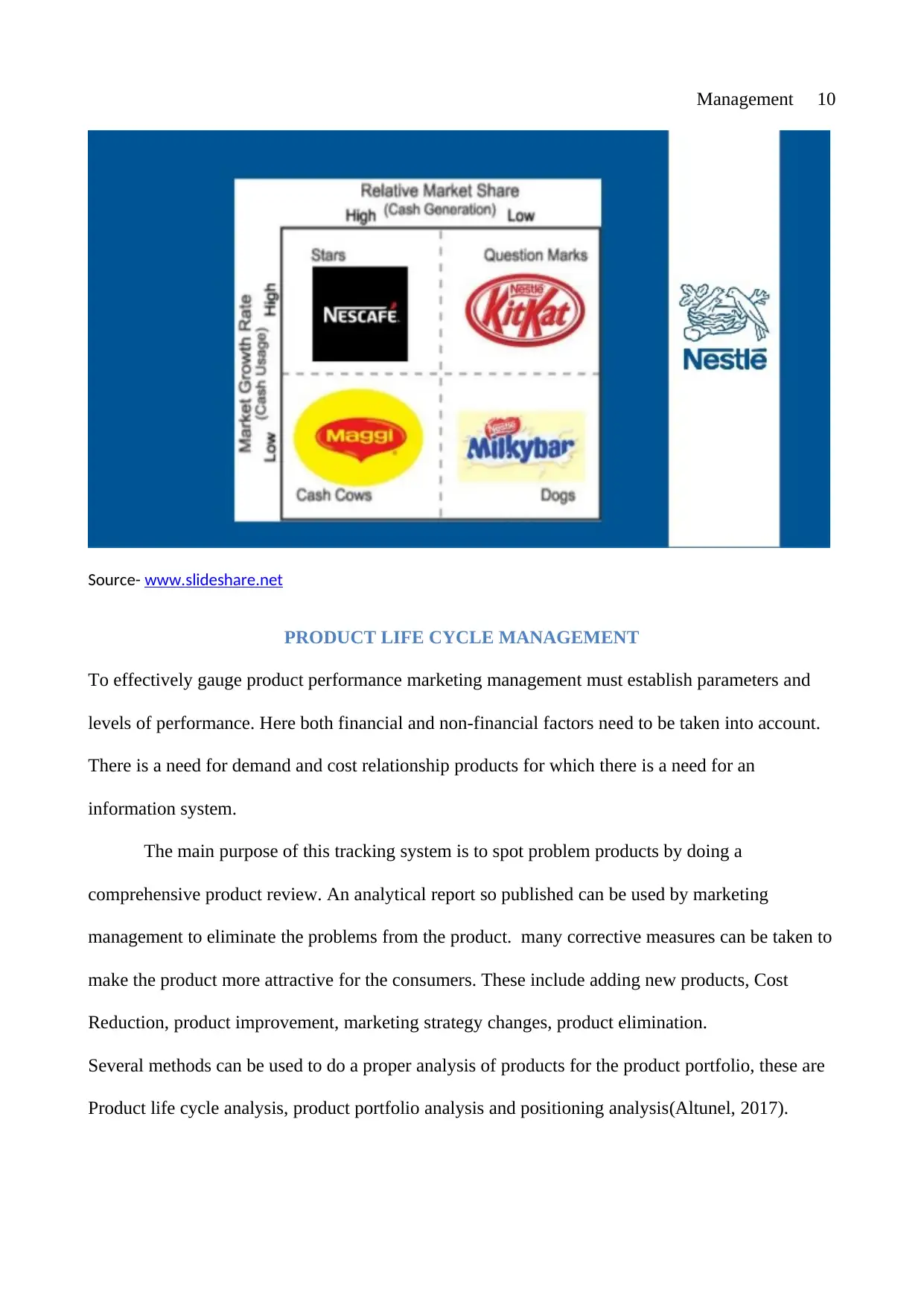
Management 10
Source- www.slideshare.net
PRODUCT LIFE CYCLE MANAGEMENT
To effectively gauge product performance marketing management must establish parameters and
levels of performance. Here both financial and non-financial factors need to be taken into account.
There is a need for demand and cost relationship products for which there is a need for an
information system.
The main purpose of this tracking system is to spot problem products by doing a
comprehensive product review. An analytical report so published can be used by marketing
management to eliminate the problems from the product. many corrective measures can be taken to
make the product more attractive for the consumers. These include adding new products, Cost
Reduction, product improvement, marketing strategy changes, product elimination.
Several methods can be used to do a proper analysis of products for the product portfolio, these are
Product life cycle analysis, product portfolio analysis and positioning analysis(Altunel, 2017).
Source- www.slideshare.net
PRODUCT LIFE CYCLE MANAGEMENT
To effectively gauge product performance marketing management must establish parameters and
levels of performance. Here both financial and non-financial factors need to be taken into account.
There is a need for demand and cost relationship products for which there is a need for an
information system.
The main purpose of this tracking system is to spot problem products by doing a
comprehensive product review. An analytical report so published can be used by marketing
management to eliminate the problems from the product. many corrective measures can be taken to
make the product more attractive for the consumers. These include adding new products, Cost
Reduction, product improvement, marketing strategy changes, product elimination.
Several methods can be used to do a proper analysis of products for the product portfolio, these are
Product life cycle analysis, product portfolio analysis and positioning analysis(Altunel, 2017).
Paraphrase This Document
Need a fresh take? Get an instant paraphrase of this document with our AI Paraphraser
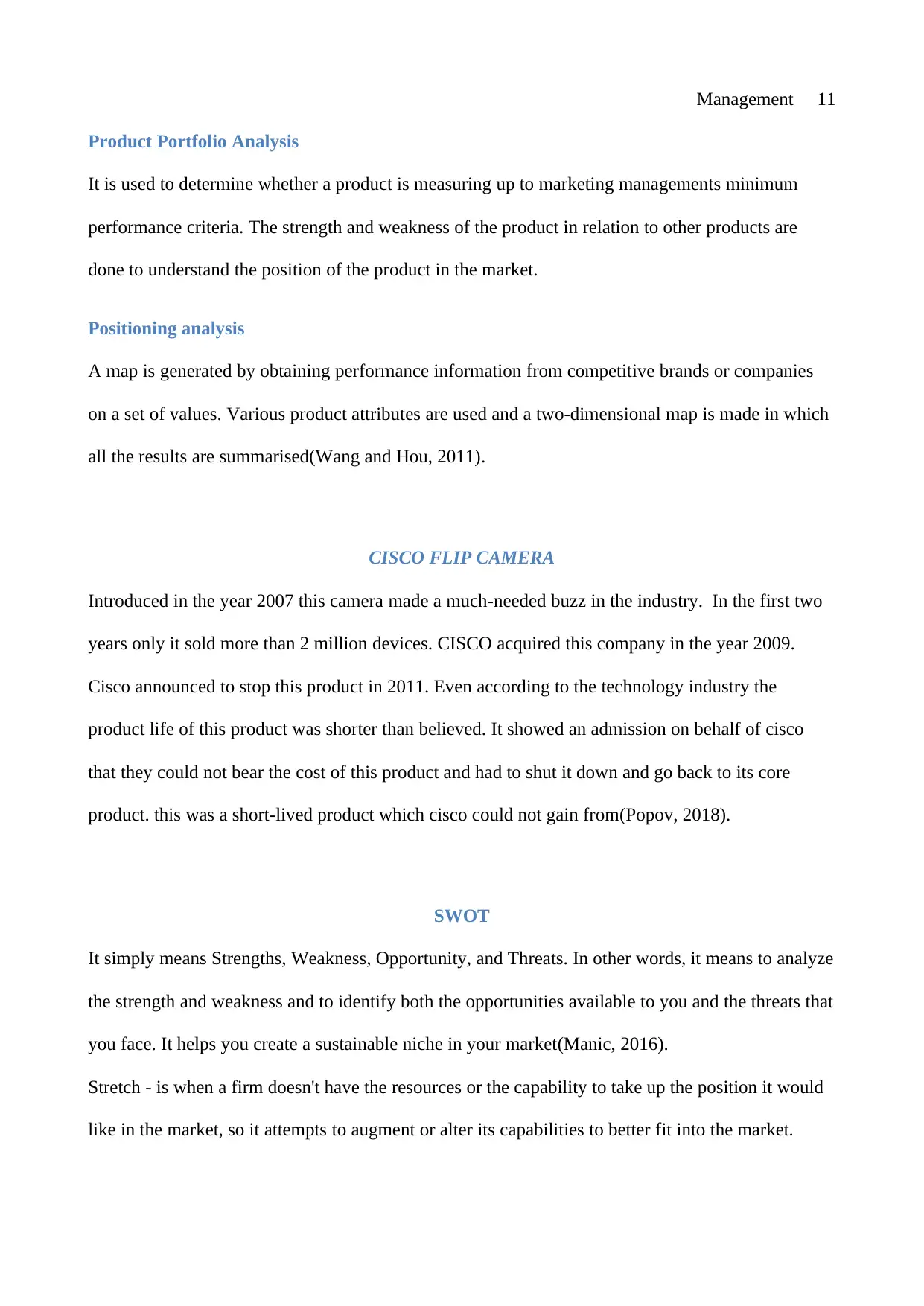
Management 11
Product Portfolio Analysis
It is used to determine whether a product is measuring up to marketing managements minimum
performance criteria. The strength and weakness of the product in relation to other products are
done to understand the position of the product in the market.
Positioning analysis
A map is generated by obtaining performance information from competitive brands or companies
on a set of values. Various product attributes are used and a two-dimensional map is made in which
all the results are summarised(Wang and Hou, 2011).
CISCO FLIP CAMERA
Introduced in the year 2007 this camera made a much-needed buzz in the industry. In the first two
years only it sold more than 2 million devices. CISCO acquired this company in the year 2009.
Cisco announced to stop this product in 2011. Even according to the technology industry the
product life of this product was shorter than believed. It showed an admission on behalf of cisco
that they could not bear the cost of this product and had to shut it down and go back to its core
product. this was a short-lived product which cisco could not gain from(Popov, 2018).
SWOT
It simply means Strengths, Weakness, Opportunity, and Threats. In other words, it means to analyze
the strength and weakness and to identify both the opportunities available to you and the threats that
you face. It helps you create a sustainable niche in your market(Manic, 2016).
Stretch - is when a firm doesn't have the resources or the capability to take up the position it would
like in the market, so it attempts to augment or alter its capabilities to better fit into the market.
Product Portfolio Analysis
It is used to determine whether a product is measuring up to marketing managements minimum
performance criteria. The strength and weakness of the product in relation to other products are
done to understand the position of the product in the market.
Positioning analysis
A map is generated by obtaining performance information from competitive brands or companies
on a set of values. Various product attributes are used and a two-dimensional map is made in which
all the results are summarised(Wang and Hou, 2011).
CISCO FLIP CAMERA
Introduced in the year 2007 this camera made a much-needed buzz in the industry. In the first two
years only it sold more than 2 million devices. CISCO acquired this company in the year 2009.
Cisco announced to stop this product in 2011. Even according to the technology industry the
product life of this product was shorter than believed. It showed an admission on behalf of cisco
that they could not bear the cost of this product and had to shut it down and go back to its core
product. this was a short-lived product which cisco could not gain from(Popov, 2018).
SWOT
It simply means Strengths, Weakness, Opportunity, and Threats. In other words, it means to analyze
the strength and weakness and to identify both the opportunities available to you and the threats that
you face. It helps you create a sustainable niche in your market(Manic, 2016).
Stretch - is when a firm doesn't have the resources or the capability to take up the position it would
like in the market, so it attempts to augment or alter its capabilities to better fit into the market.
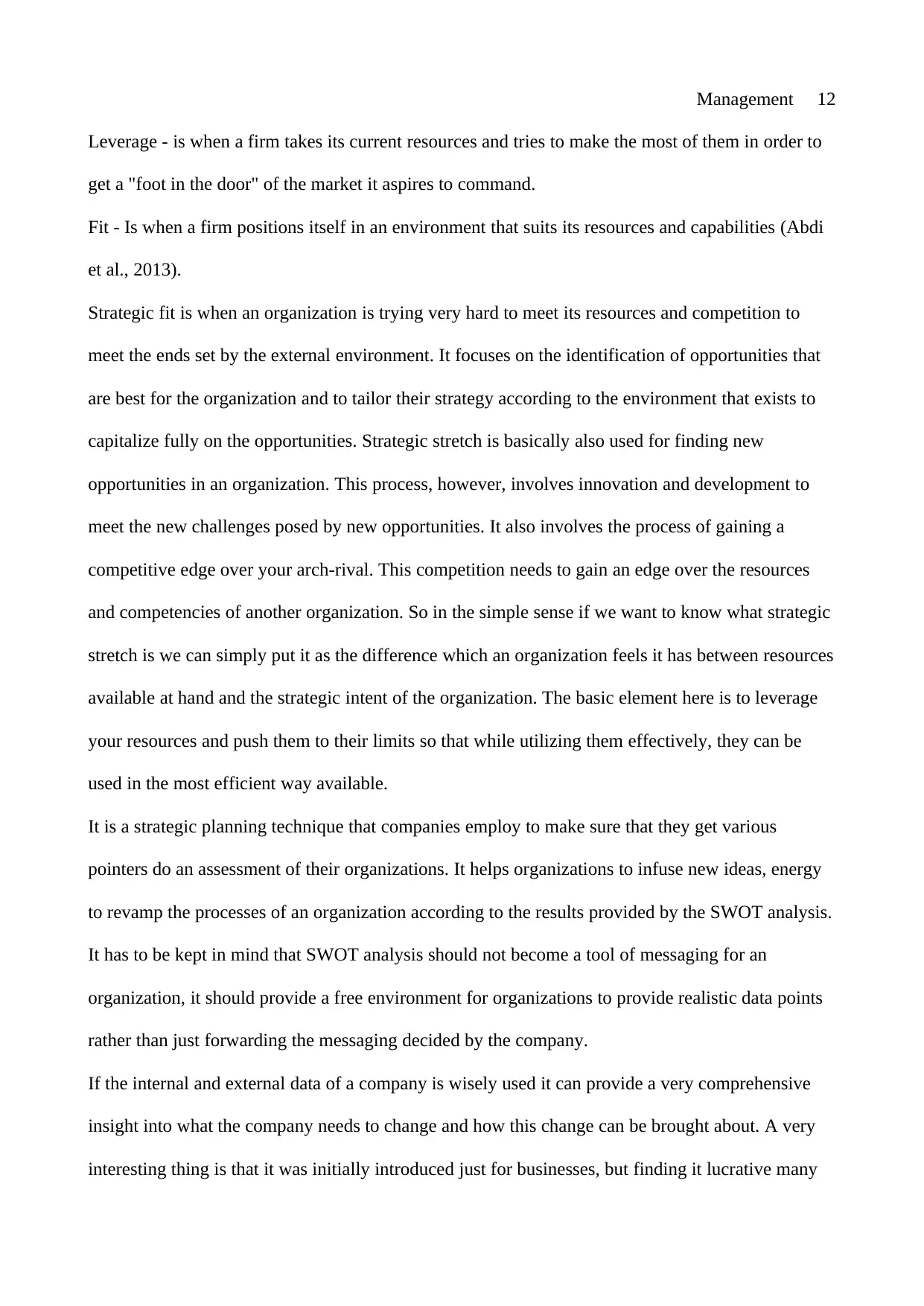
Management 12
Leverage - is when a firm takes its current resources and tries to make the most of them in order to
get a "foot in the door" of the market it aspires to command.
Fit - Is when a firm positions itself in an environment that suits its resources and capabilities (Abdi
et al., 2013).
Strategic fit is when an organization is trying very hard to meet its resources and competition to
meet the ends set by the external environment. It focuses on the identification of opportunities that
are best for the organization and to tailor their strategy according to the environment that exists to
capitalize fully on the opportunities. Strategic stretch is basically also used for finding new
opportunities in an organization. This process, however, involves innovation and development to
meet the new challenges posed by new opportunities. It also involves the process of gaining a
competitive edge over your arch-rival. This competition needs to gain an edge over the resources
and competencies of another organization. So in the simple sense if we want to know what strategic
stretch is we can simply put it as the difference which an organization feels it has between resources
available at hand and the strategic intent of the organization. The basic element here is to leverage
your resources and push them to their limits so that while utilizing them effectively, they can be
used in the most efficient way available.
It is a strategic planning technique that companies employ to make sure that they get various
pointers do an assessment of their organizations. It helps organizations to infuse new ideas, energy
to revamp the processes of an organization according to the results provided by the SWOT analysis.
It has to be kept in mind that SWOT analysis should not become a tool of messaging for an
organization, it should provide a free environment for organizations to provide realistic data points
rather than just forwarding the messaging decided by the company.
If the internal and external data of a company is wisely used it can provide a very comprehensive
insight into what the company needs to change and how this change can be brought about. A very
interesting thing is that it was initially introduced just for businesses, but finding it lucrative many
Leverage - is when a firm takes its current resources and tries to make the most of them in order to
get a "foot in the door" of the market it aspires to command.
Fit - Is when a firm positions itself in an environment that suits its resources and capabilities (Abdi
et al., 2013).
Strategic fit is when an organization is trying very hard to meet its resources and competition to
meet the ends set by the external environment. It focuses on the identification of opportunities that
are best for the organization and to tailor their strategy according to the environment that exists to
capitalize fully on the opportunities. Strategic stretch is basically also used for finding new
opportunities in an organization. This process, however, involves innovation and development to
meet the new challenges posed by new opportunities. It also involves the process of gaining a
competitive edge over your arch-rival. This competition needs to gain an edge over the resources
and competencies of another organization. So in the simple sense if we want to know what strategic
stretch is we can simply put it as the difference which an organization feels it has between resources
available at hand and the strategic intent of the organization. The basic element here is to leverage
your resources and push them to their limits so that while utilizing them effectively, they can be
used in the most efficient way available.
It is a strategic planning technique that companies employ to make sure that they get various
pointers do an assessment of their organizations. It helps organizations to infuse new ideas, energy
to revamp the processes of an organization according to the results provided by the SWOT analysis.
It has to be kept in mind that SWOT analysis should not become a tool of messaging for an
organization, it should provide a free environment for organizations to provide realistic data points
rather than just forwarding the messaging decided by the company.
If the internal and external data of a company is wisely used it can provide a very comprehensive
insight into what the company needs to change and how this change can be brought about. A very
interesting thing is that it was initially introduced just for businesses, but finding it lucrative many
⊘ This is a preview!⊘
Do you want full access?
Subscribe today to unlock all pages.

Trusted by 1+ million students worldwide
1 out of 18
Related Documents
Your All-in-One AI-Powered Toolkit for Academic Success.
+13062052269
info@desklib.com
Available 24*7 on WhatsApp / Email
![[object Object]](/_next/static/media/star-bottom.7253800d.svg)
Unlock your academic potential
Copyright © 2020–2025 A2Z Services. All Rights Reserved. Developed and managed by ZUCOL.





